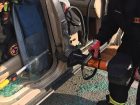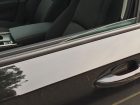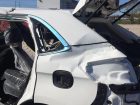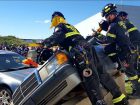
Extrication tips: October 2018
By Chad Roberts
Features Extrication Training extrication trainingWe’ve all heard the sayings throughout our careers in the fire service like, “Take a minute to make a minute,” and, “Work smarter, not harder,” or even, “Try before you pry.”
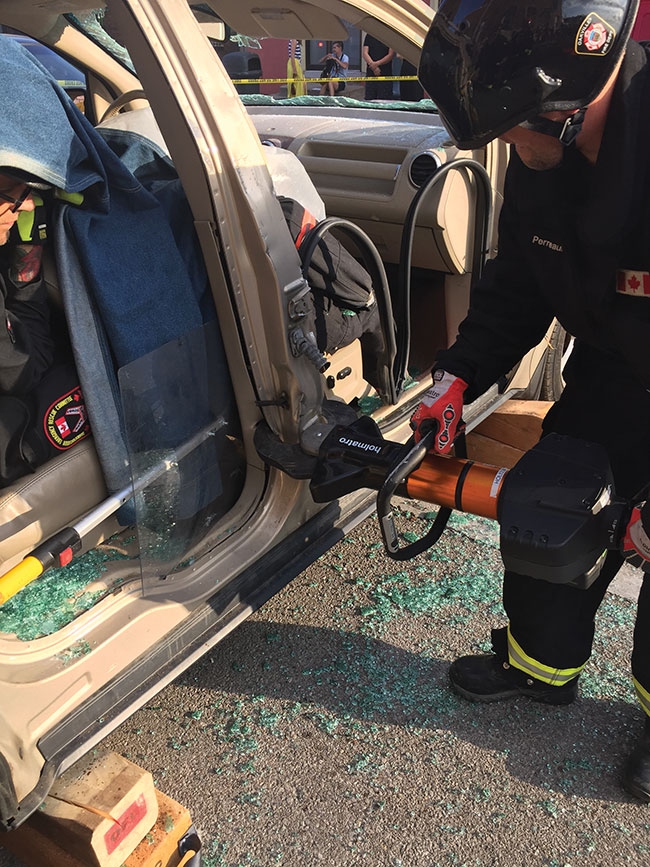 By making an initial cut perpendicular to the B pillar Firefighter Chad Roberts shares how important it is to take a moment and think about what is laid out in front of you as firefighters begin an extrication.
By making an initial cut perpendicular to the B pillar Firefighter Chad Roberts shares how important it is to take a moment and think about what is laid out in front of you as firefighters begin an extrication.To sum these all up, the simpler statement may be, “Slow down and take a moment to think about what is laid out in front of you.”
Most major mishaps in our business can almost always be attributed to moving too quickly and not taking the time to weigh the situation. The fire service is made up of many different members, all with different ways of thinking for a reason.
We have a chain of command and ICS laid out to help us slow down and effectively evaluate before acting. By using both of these attributes in extracting a person from an automobile, we can help solve complex situations, as well as make those complex calls simpler than ever imagined.
With this being said, I’m going to quickly address some time-saving tips, with and without our tools.
The first tip was previously addressed and that is the notion of, “Try before you pry.” While I know this may seem like a no-brainer concept, it is often overlooked.
A lot of times, the door of where a person is trapped is the only one checked then we head straight to the tools. Check all doors and hatchback openings in a vehicle. This can provide early access to the person, create an emergency egress point if the condition worsens, or help you with selecting or influencing an extrication plan.
Take a minute to move the seats back, get the steering wheel out of the way, totally remove the headrests, and tilt the seats back to facilitate removal of the person before cutting battery power to any mechanisms. A few of these simple movements inside the vehicle can save you taking the back of a seat apart to lower it.
Before breaking all the windows of a vehicle, take an extra second to lower them into the doors before the battery power is cut. By leaving a small amount of glass exposed, it can be broken quite easily and all the shards are contained within the door.
Take a moment to get a 360-degree look at the scene. Get a view of the entire vehicle and make multiple plans. If something doesn’t seem to be working, go to a different option or plan altogether. If the rear door is giving you issues on a full-side removal, reposition and start from the front door and move your way back. There is no set plan in auto extrication. Like anything, there is a blueprint, but being able to approach the scene from different angles and develop multiple plans is a must with any extrication.
When it comes to the tools, we have to talk about the B pillars. In the auto industry, B pillars are becoming monsters – not only in regards to their size, but also to the fact they’re made of reinforced and synthetic steels. When dealing with these new B pillars, the reciprocating saw is quickly becoming a non-option in terms of cutting through boron-type steels.
When cutting, we must consider that most of the strength in these B pillars is in the middle to protect the driver. The weaker points of the pillars are at the top and bottom connection. Therefore, when cutting larger and stronger B pillars, we need to keep our cuts high and low.
When dealing with an issue related to size in regards to the bottom of the B pillars, a series of cuts will need to be made. Make your first cut directly perpendicular to the base of the B post. You’re never going to make it all the way through, but you’re making a breakpoint in the reinforced steel and reducing its overall strength. Second, you are creating a purchase point for your cutter blades for your next two cuts to finish off the rest of the B pillar base (one parallel cut from the back seat and one parallel cut from the front seat). By reducing the strength with that first cut, the second and third cuts with the cutters will naturally travel toward the cut and away from the interior of the vehicle and occupants.
Next, let’s move to the C, and depending on the vehicle, D pillars. These are other parts of vehicles that are also taking on a new look in terms of size. Much larger C- and D-pillar construction can call for a different approach. When tasked with cutting through these pillars, whether it be for a roof removal or a blowout, the use of hydraulic cutters or combination tools would do the job, but it can be time-consuming because several cuts would be required to get through all the metal. A simple step back to re-evaluate could lead you to using the reciprocating saw for this operation by making one quick horizontal cut rather than three to four cuts with hydraulics. If you don’t have the option of a reciprocating saw, try squeezing the large C and D pillars with your spreaders to condense them into a small section to cut. You may be able to make the cut in one or two cuts with hydraulic cutters.
By taking an extra minute to create space, looking at everything from different angles, and even making small adjustments in your toolwork, you can make more efficient extrications. By practising these time-saving tips and incorporating them into your everyday calls and training sessions, they will become second nature and you will continue to move on to even more finite things to improve your skills. So, until next time, keep your eyes and ears open and never stop learning.
Chad Roberts is a firefighter in Oakville, Ont. He is a member of the Oakville extrication team and competes and trains across North America. Contact Chad at chadroberts12@gmail.com.
Print this page
